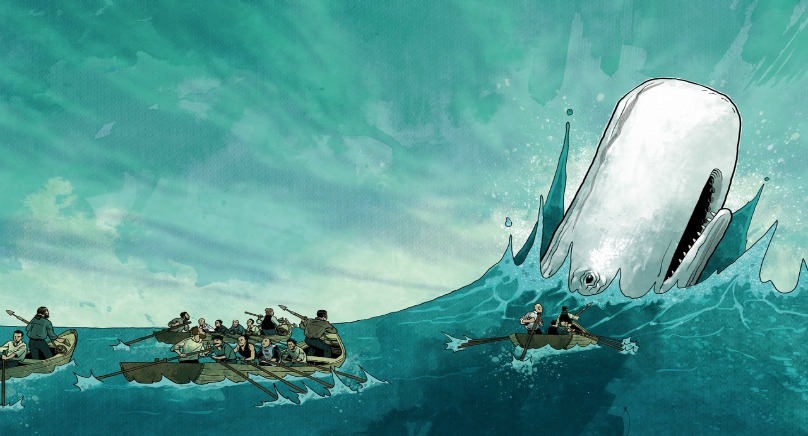Appendix:
It’s NatMysteryCast’s first ever two-part episode! We’re taking a look at two famous whales that inspired Herman Melville to write his novel Moby Dick. In this first half, we focus on the evolution of whales, the history of whaling, and the legend of Mocha Dick, the ferocious white whale of the Pacific.
How could a seemingly peaceful creature like a whale sink and destroy a large whaling vessel? It’s easy to forget that whales are the product of millions of years of predatory evolution. Sperm whales, the species to which Moby Dick belongs, aren’t even the most savage of the many members of the whale lineage. Here’s a look at where whales started out, and how they got where they are today:
Indohyus


Indohyus was a small, omnivorous whale ancestor that resembled a cross between a shrew, a deer, and maybe a pig. Its name means “India’s pig.” Only about the size of a raccoon, indohyus lived during the Eocene, about 55 million years ago. Although a land-dweller, its fossil remains tell us that it had the beginnings of adaptations for aquatic life: a thick, heavy coat and bones designed to reduce buoyancy so that it could remain underwater. Unlike its descendants, indohyus probably didn’t do its hunting in water. Rather, scientists believe it probably adopted a survival strategy of diving into the water to escape predators, and remaining hidden until the danger had passed.
Pakicetus


Pakicetus, or “Pakistan whale,” came a few million years later, during the early to middle Eocene, and is largely considered to be the most basal whale. Pakicetus was about 1-2 meters long and had long legs, which some scientists believe allowed it to take indohyus’s water adaptations to the next level. Pakicetus may have stood fully submerged in water save for its eyes, which are located near the top of its head, peeking out above the surface for danger and possibly even hunting in a fashion similar to crocodiles.
Ambulocetus


Ambulocetus’s name means “walking whale,” but unlike indohyus and pakicetus, it probably spent more of its time in the water than on land, if it spent any time on land at all. Ambulocetus was fully adapted for life in water, and most likely swam by undulating its back up and down as we see in modern otters, and of course in whales and dolphins. It had thick, powerful jaws, and most likely ambushed prey before holding it underwater to drown it, much like crocodiles do today.
Basilosaurus


At first glance, basilosaurus looks like a mosasaur. Its name means “king lizard,” because even scientists thought it must be some kind of reptile upon its discovery. However, basilosaurus is a mammal just like any other whale, and one fully adapted for life at sea. The 50-60 ft long, 60-ton basilosaurus terrorized the oceans during the late Eocene about 40 million years ago. It’s a great representation of what modern whales might look like if they weren’t carrying around all that blubber. Although basilosaurus’s limbs had become flippers and it had developed a long, powerful tail for swimming, it still retained its small, relatively useless hind limbs, which would be lost altogether in later whale species.
Livyatan


Livyatan melvillei is a far more recent entry on the whale timeline. Named for Herman Melville, it is an extinct relative of the sperm whale that existed roughly 9 million years ago, when sperm whales were apex predators of the ancient oceans. While most whale species have lost their teeth over time, trading them out for baleen (the brush-like structures that allow them to catch microorganisms like krill), livyatan retained a full set of 14-inch daggers. Even today’s sperm whales only have functional teeth in their lower jaws for catching squid, but livyatan was thought to prey on sharks and other whale species. For comparison, here’s the skull of a modern sperm whale:

Mocha Dick

That’s not to say that today’s whale species aren’t plenty dangerous. Mocha Dick was a real life white sperm whale that swam the waters near Mocha Island off the coast of Chile. He was both feared and revered by whalers of the early 1800s. Legend has it that over 100 whaling ships tried to defeat him, and Mocha Dick either destroyed their vessels or escaped their longboats nearly every time. By the legend’s count, he sank at least 20 whaleships in his lifetime. He was eventually bested while trying to rescue a female whale that had been harpooned, taking a fatal lance himself.

Sources:
Mocha Dick: Or The White Whale of the Pacific by Jeremiah N. Reynolds
The History of Whaling in America by PBS
The land-based ancestor of whales by Katharine Sanderson
The First Whale: Pakicetus by American Museum of Natural History
A Walking Whale: Ambulocetus by American Museum of Natural History
Behold Leviathan Livyatan: the sperm whale that killed other whales by Ed Yong
Museum Management:
Museum theme by Michael Guy Bowman
Listen to more at: bowman.bandcamp.com
Rachel: Designer #UkuleleWitch @rachelvice
Tour Guide: Emery Coolcats
Twitter: @natmysterycast | Email: natmysterypodcast@gmail.com | Home: pome-mag.com/category/pomecast
Follow the show on iTunes or Soundcloud!
Museum of Natural Mystery is part of the POMEcast network, and thanks a million to the ladies of POME for helping this show get up and running! But above all, thank you for listening!




